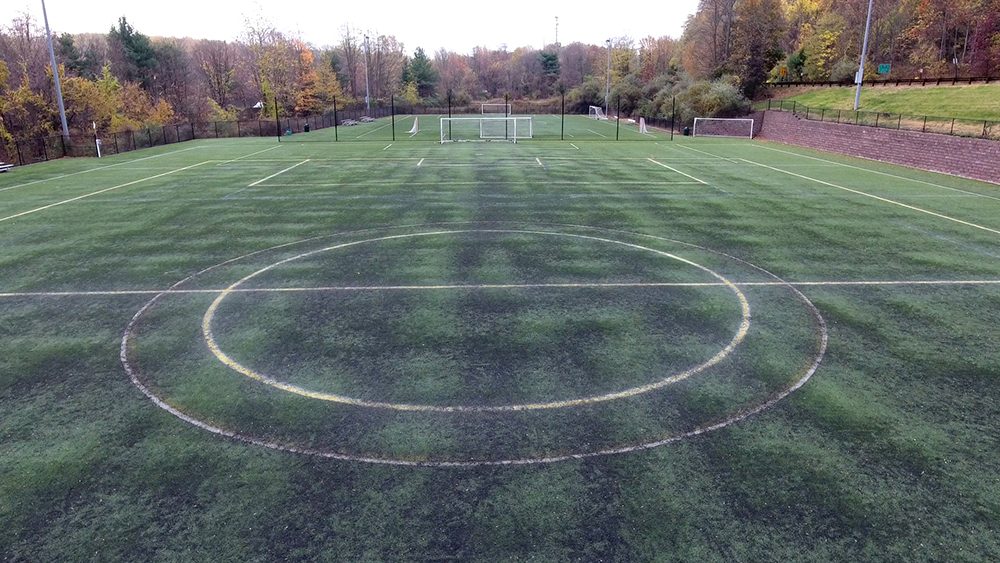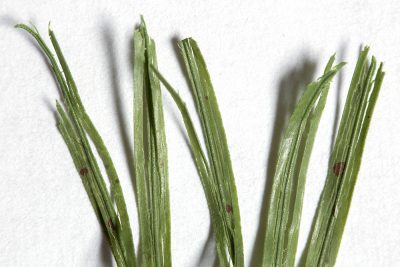Advertisement
Uncovering The Deception Behind Duraspine's Alleged Failures

Christopher Baxter and Matthew Stanmyre are veteran enterprise newspaper reporters who never thought they’d spend six months looking into “fake” grass. But their investigation for the Newark Star-Ledger and NJ Advance Media led them to some unexpected places.
This is not the story you’d expect to hear about artificial turf. It’s not a story about injuries — even though there were a lot of injuries in the early days of AstroTurf. And it’s not a story about whether artificial turf is making people sick — even though scientists are looking into possible links to cancer and other illnesses.
This is a story about money. Correction: It’s a story about lots of money — mostly paid by taxpayers.
These fields cost $300,000 to $500,000 each. Fourteen-hundred of them were installed across the U.S. between 2005 and 2012. Chris Baxter and Matt Stanmyre estimate the fields brought in around $570 million in revenue — and that’s just for the turf. And at times, these projects were going through even as communities were laying off teachers and police officers.
"We’re not talking about books or school supplies. We’re not talking about a car. We’re talking about a half-million dollar or more turf field," Chris says. "We think that those taxpayers that paid those bills have a right to know the story behind this turf and what the company knew and what it has and hasn’t told them about the product."
"I think that’s the biggest reason why Chris and I felt compelled to pursue this story," Matt says. "Because we just felt like taxpayers had the right to know."
The Tip Comes In
We’ll get to what Chris and Matt found, but first I want to talk a little about how they found it. It all started with an email tip Chris received.
"There’s all sorts of pictures and links — and there’s like five different sizes of fonts," Chris says. "And the first time I saw it I was like, what is this?
So, Chris set it aside.
"The next day or two I went back and opened some of the links, and I read some of the stories," he says.
But Chris set the tip aside again. He brought in Matt and asked him what he thought.
"I do remember my eyes glazing over just a little bit," Matt says.
But Chris just couldn’t give up on the idea. So he opened the email again and followed a link to the court record for a 2011 lawsuit brought by the artificial turf industry leader, FieldTurf, against the maker of what had been their top product, Duraspine. And Chris found, buried among the hundreds of documents already available online, half a dozen transcripts that hadn’t yet been released.
Advertisement
NJ Advance Media filed the first of what would be 40 public record requests. Eventually, they would obtain more than 5,000 pages of internal company records, emails, court filings and testimony. And they found something that more than a dozen attorneys in six states have told them appears to be deceptive advertising and fraud.
Reporting From The Field
While Chris Baxter focused on thousands of pages of testimony and emails and other documents, Matt Stanmyre became the team’s eyes on the ground, so to speak.
"You know, we were talking about the fields for so long — we had probably been discussing them for weeks on end — and I said, 'You know what? I wanna go see one of these Duraspine fields for myself,'" Matt recalls.
Matt knew the coaches at Malcolm X Shabazz High School in Newark, so he decided to just stop by on his way home from work one day to check out their field. It had been installed in December of 2008.

"I pulled up to the school just as practice was ending, and there was only one coach left on the field. And they always lock the field at the end of the day. And I said, 'Hey, Don, Don. It’s me. It’s Matt. Can you open up the gate for me?' And he said, 'Oh yeah, come on in. Come on in.' So he let me on to the field, and it was just me and this assistant coach named Don Massey.
"The field just kind of looked like a flat carpet that you’d see in any kind of office building or in your house. You know, there were some places on the field at Shabazz where they had replaced some of the turf, and the replacement turf was not Duraspine, and it was much sturdier. When you grabbed that replacement turf and tried to rip it out, it wouldn’t budge. But when you grabbed the Duraspine fibers right next to it, you could tear it out really easily."
Following A Road Map
Neither Matt Stanmyre nor Don Massey are experts in artificial turf. FieldTurf told customers that Duraspine fields would last for 10 years or more, the fields are warrantied for eight and whether an artificial turf field looks good for its age is subjective --and that’s important.
"We did speak to, I would say, a significant portion of New Jersey coaches who were very pleased with the product that they got from FieldTurf," Matt says.
But what Chris Baxter was beginning to wonder, as he was reading through all those internal emails and court testimony, was whether those schools and coaches would still be happy, if they knew everything he was uncovering.
"I read every word of every transcript I got," Chris says. "And then I read them again and again. And on the second and third time, you start to realize they are referencing emails, field trips. That starts to provide a road map.
"The more I dug in, the more documents I found that very clearly laid out what the executives at the company knew and what they were discussing."
The Origin Of FieldTurf
For us to understand those conversations, we’re going to first need a quick history of FieldTurf, Duraspine and the company’s founder, John Gilman.
"Yeah, so John Gilman, was for most of his life, he was a luggage salesman. And he lived in Montreal," Chris says.
John Gilman had been a backup quarterback in the Canadian Football League for a while. Later, his sport was tennis. And his doubles partner, a guy named Jean Prevost, had patented a new type of fake grass. He was installing it on private tennis courts for very rich clients.
But John Gilman saw a much bigger market for this new type of artificial turf.
"And this was sort of — from what I’m told in our reporting — sort of classic John Gilman," Chris says. "He was ever the opportunist, always looking for, you know, the next, sort of, big thing."
At the time, AstroTurf was the leading turf maker — but AstroTurf was expensive, and there was that injury issue. FieldTurf, Gilman and Prevost’s new product, had these long pieces of plastic grass that had been filled in with a combination of crushed rubber and sand.
"And it turned out that that system was less abrasive and provided more padding. And very quickly it took off," Chris says.
Duraspine: 'The Gold Standard'
Before long, FieldTurf had replaced AstroTurf as the industry leader. But the Star-Ledger’s reporting suggests that by the early 2000s, FieldTurf was concerned that their competitors were catching up.
In November of 2003, John Gilman was shown a new kind of artificial grass fiber. In early testing, this fiber seemed to be more resistant to sunlight, which would make it more durable than anything else on the market. They called it Duraspine.
"Duraspine was the premium product. It was the Mercedes, the gold standard," Chris says. "And in New Jersey, it was like as soon as one town got it, the competitor across the way who they played in football or soccer or whatever, suddenly they wanted one. I mean, these fields, when they went in new, they were stunning. They had this gloss on them, and the lines were just whiter and brighter and straighter than anything you had ever seen. And you walked into a high school stadium, and it looked like the pros. It looked like the best."
"It looked like actual grass," says Darnell Grant, head football coach at Malcolm X Shabazz High School. "When the wind would blow, you would see the turf kinda go with the wind. It was just an awesome, an awesome visual."
When Grant arrived at the school in 2010, the field was less than two years old.
"It was beautiful. It was just a great place. That’s one of the reasons I took the job here," Grant says.
"Oh, really? The field was so nice, you thought this was a good place to go?" I ask.
"Yeah, I thought that with great facilities like that, it was going to be easy to develop the guys."
As Time Goes On...
But as the field started to get five and six years old...
"Right about around maybe 2013, 2014, it started to become matted. And then around 2014, started noticing there was tearing — like the middle of the field was coming up, and it was ripped in the end zone — things of that nature," Darnell says. "We thought at first maybe it was vandalism, but then after a while we saw it was a common occurrence."
The school called FieldTurf, but Darnell says the company said the wear and tear was normal.
"They sent the crew down, they would throw some glue down and glue it down and that would be a good, temporary fix," he says. "And then in two or three months it would tear again."
Last year, the field was in such bad shape, Darnell Grant considered cancelling some games.
It’s probably worth mentioning here that Shabazz isn’t a rich, suburban school that can come up with another $500,000 for a new field. Darnell tells me that the school is urban — with all the “special” things that come with that. Matt Stanmyre tells me that Darnell’s players have been shot at on their way home from practice.
"There’s a lot of struggle, a lot of difficulties here in the city, a lot of things we deal with," Darnell said in an interview with Matt. "And at least in sports you have a level playing field. It’s not a socioeconomic thing. It’s not a color thing. It’s just a game. And when the level playing field, there’s something wrong with that, it’s like, come on, man."
'Unmatched Durability' And 'Added Longevity'
So what went wrong with Duraspine? Chris Baxter picks up the story.
"So, the very earliest sign came actually in 2005," Chris says.
That’s the very first year Duraspine was available. FieldTurf was contacted by the supplier of one of its other products who said they had tested Duraspine, too, and their tests showed different results: The fiber didn’t stand up well to wear and tear.
"John Gilman sort of batted this about internally and wondered if they had 'erred in their overexuberance,'" Chris says.
But, still, the Duraspine marketing pitch promised “unmatched durability.”
"And then in 2006, an email came in from FieldTurf’s operations director in Latin America — this woman, Laura Braga. And she reported that fields that had been put down in South America, in particular she was talking about fields in Chile, were wearing rapidly and were deteriorating rapidly," Chris says. "And she said that the Chileans were reporting that the slit film fields that were several years old were in better condition than the Duraspine fields that had literally just been put in and had barely been used."
But still, the Duraspine marketing pitch promised quote “added longevity.”
"Duraspine was the premium product. It was the Mercedes, the gold standard. And in New Jersey, it was like as soon as one town got it, the competitor across the way who they played in football or soccer or whatever, suddenly they wanted one."
Chris Baxter
Meanwhile, John Gilman was emailing back and forth with the manufacturer of Duraspine, wondering what had changed since the product was tested.
"Sometimes you just come across those quotes that click in your head, and you think, 'This is the whole story. This is it,'" Chris says. "It was on New Year’s Eve, 2006..."
So, picture this, it’s New Year’s Eve, and John Gilman, founder of FieldTurf, is emailing his manufacturer saying:
“It’s all about that old story of waiting for the next shoe to drop. We have had a few failures as you know. The question is ... will many others fail? Who knows?”
"Twenty-twenty hindsight, you look back and you think, 'Wow that was a pretty ominous and pretty spot on quote,'" Chris says. "Years and years before hundreds of fields started falling apart."
But John Gilman didn’t call up his marketing staff to tell them to stop selling Duraspine.
"Yeah, no. Definitely not. I mean at this point, Duraspine was taking off," Chris says. "It was FieldTurf’s cash cow. It was their exclusive product. Nobody wanted to step in front of the train."
'You Would Be Asking Me To Commit A Possible Crime'
Seven months later, John Gilman died of a sudden heart attack. According to court records, later that year, Gilman’s son, Ken, arranged a field trip for FieldTurf executives to New Jersey to educate the company’s interim CEO about the problems with Duraspine.
"It’s not clear which fields the group visited, but the observations from that trip were later summarized in an email sent by Ken Gilman to the group," Matt says. "This email we were able to obtain, and it really laid out, clear-cut, some of the issues they were finding with DuraSpine based on this field trip. Quote: 'This yarn is nowhere near as robust or resilient as we initially thought and probably will not last that much longer than a high quality slit film yarn.'”
Gilman told executives that Duraspine fields would likely show significant signs of wear in years five and six. And he said, “Our marketing claims and sales pitches need to reflect this reality.”
"They sent the crew down, they would throw some glue down and glue it down and that would be a good temporary fix. And then in two or three months it would tear again."
Darnell Grant
But Duraspine didn’t change its marketing claims and sales pitches. Gilman wrote another email: “It’s our lawyer’s opinion that this email thread contains information that could be used against us in a lawsuit as it is 'discoverable.'"
About the email chain he had started, Ken Gilman asked, “Can we somehow get it zapped off?”
FieldTurf’s technology consultant said that the email chain was probably in too many places to be wiped clean. Besides, he said, "Legally it is not possible. You would be asking me to commit a possible crime.”
That was 2007. FieldTurf’s sales of Duraspine peaked in 2008.
In the fall of 2009, FieldTurf says they noticed an increase in warranty claims, especially for fields in the South and Southwest – where the sunlight is the strongest. The company sued their supplier saying, basically, that they had been the victims of a bait and switch. Duraspine was discontinued. The parties settled out of court.
FieldTurf had now sued its manufacturer for selling them a defective product — and inadvertently provided Chris and Matt with what they’d need to start their investigation — but they still didn’t contact every customer to notify them of the problem.
"This is really important," Chris says. "And that’s because a lot of these schools and towns had never owned a turf field before they had a Duraspine field. They weren’t experts in artificial turf, nor should they expected to be. So they didn’t know and still many don’t know how they should behave, and how they should wear, how they should look after a certain period of time."
Aftermath
FieldTurf would not agree to an on-the-record interview for this story, but after the Newark Star-Ledger investigation came out last Sunday, FieldTurf released a statement saying, “We believe this story paints a highly misleading picture of the Duraspine issue and what kind of company FieldTurf is.”
The statement further contends that the issue affected only a small percentage of fields, has never been nationwide and doesn’t affect safety. The statement invites any customer with concerns about their field to contact FieldTurf.
That’s not enough for former New Jersey governor and current state senator Richard Codey. When he read the Star-Ledger story last weekend, especially that part where the technology consultant refused to delete the email, his response was:
"Gotcha. Simple as that. They’ve committed fraud. I’ve suggested to the school boards they file a class action lawsuit."
Codey’s been calling up school superintendents and asking them to join in the lawsuit to recoup taxpayer money.
"We’ve had a couple sign up already and when I get off the phone with you, that’s what I’m going to be doing," he says.
Late on Wednesday, the Newark school system became the first to file suit. The district owns several Duraspine fields, including the one at Malcolm X Shabazz High School.
1,428 Duraspine fields were installed across the United States, especially in California, New York, Texas, Washington, Pennsylvania, Illinois and Massachusetts. Was a Duraspine field installed in your community? Find out here.
This segment aired on December 10, 2016.


